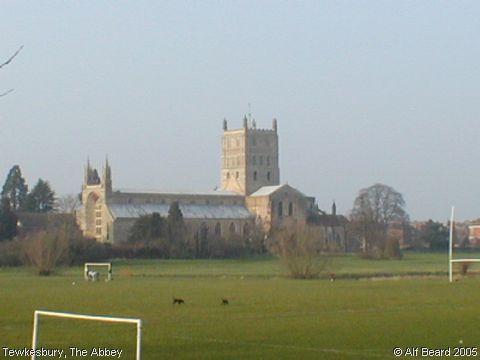The Abbey, Tewkesbury
The first Christian church at Tewkesbury appears to have been built in the latter part of the 7th century by a missionary monk named Theoc, from whom the place derived the name Theocsbury, now softened into the modern form of Tewkesbury. The hermitage established by Theoc was afterwards developed into a Saxon monastery in the year 715 by Odo and Dodo, Saxon dukes or earls of Mercia, who were afterwards buried at Pershore about 725 A.D., the name of one of whom seems to have been perpetuated in that of the hundred of Dudstone. In the 11th century, a later Earl, Odda or Agelwin, of Mercia, who died August 31, 1056, and was also buried at Pershore, was a great benefactor to the foundation, then only a priory. Subsequently it became the property of Matilda, wife of the Conqueror, and at her death, in 1083, was merged in the Crown. William Rufus granted it, on his accession, to his kinsman, Robert FitzHamon, Lord of Astremville in Normandy, who in 1102 refounded the monastery and rebuilt the church from its foundations, but died March 15, 1107, before the completion of the work, and was eventually buried in the church by Abbot Forthington in 1241, the chantry chapel over his remains being erected by Abbot Parker in 1397. The unfinished buildings were completed by Robert Fitzroy, a natural son of Henry I. and first Earl of Gloucester, who had married the daughter of FitzHamon, and the church was consecrated November 20, 1123. In 1178 a great fire occurred, by which a large portion of the monastic buildings were destroyed. In the 15th century, by the munificence of the Despencers, the spendidly-groined roofs of the church and the fine clerestory of the choir were built and several of the chantry chapels added. The abbey was finally suppressed in 1539, and was surrendered to the king, January 9 in that year, by the Abbot, John Wiche, or Wakeman, and 38 monks, its annual revenue being estimated at £1,595 15s. 6d. a sum equivalent to about £40,000 in the present day. Most of the conventual buildings were then destroyed, but the church was purchased by the inhabitants for £453, or more than £5,000 of our money, being the current value of 175 tons of lead taken from different places, and of the bells weighing 14,600lbs. Wakeman, the last abbot, retired on a pension of £266 13s. 4d. with Fortington (now Forthampton) Court as a residence, and on 15 Sept 1541, he was consecrated first bishop of Gloucester. [Extract from Kelly's Directory of Gloucestershire, 1923] (Information provided by Rosemary Lockie)
Image contributed by Alf Beard on 2nd August 2005.
|
||
